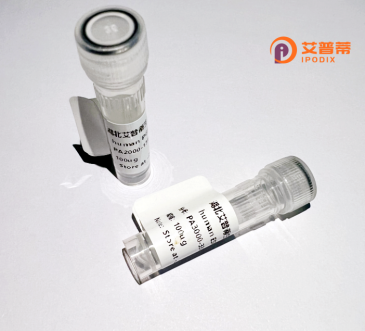
| 纯度 | >90%SDS-PAGE. |
| 种属 | Human |
| 靶点 | ADORA3 |
| Uniprot No | P0DMS8 |
| 内毒素 | < 0.01EU/μg |
| 表达宿主 | E.coli |
| 表达区间 | 1-318aa |
| 氨基酸序列 | MPNNSTALSLANVTYITMEIFIGLCAIVGNVLVICVVKLNPSLQTTTFYFIVSLALADIAVGVLVMPLAIVVSLGITIHFYSCLFMTCLLLIFTHASIMSLLAIAVDRYLRVKLTVRYKRVTTHRRIWLALGLCWLVSFLVGLTPMFGWNMKLTSEYHRNVTFLSCQFVSVMRMDYMVYFSFLTWIFIPLVVMCAIYLDIFYIIRNKLSLNLSNSKETGAFYGREFKTAKSLFLVLFLFALSWLPLSIINCIIYFNGEVPQLVLYMGILLSHANSMMNPIVYAYKIKKFKETYLLILKACVVCHPSDSLDTSIEKNSE |
| 预测分子量 | 36,1 kDa |
| 蛋白标签 | His tag N-Terminus |
| 缓冲液 | PBS, pH7.4, containing 0.01% SKL, 1mM DTT, 5% Trehalose and Proclin300. |
| 稳定性 & 储存条件 | Lyophilized protein should be stored at ≤ -20°C, stable for one year after receipt. Reconstituted protein solution can be stored at 2-8°C for 2-7 days. Aliquots of reconstituted samples are stable at ≤ -20°C for 3 months. |
| 复溶 | Always centrifuge tubes before opening.Do not mix by vortex or pipetting. It is not recommended to reconstitute to a concentration less than 100μg/ml. Dissolve the lyophilized protein in distilled water. Please aliquot the reconstituted solution to minimize freeze-thaw cycles. |
以下是关于ADORA3重组蛋白的3篇代表性文献的简要总结:
1. **《Recombinant human adenosine A3 receptor: characterization and ligand binding properties》**
- 作者:Salvatore E, et al.
- 摘要:研究通过昆虫细胞表达系统成功制备重组人ADORA3蛋白,并利用放射性配体结合实验验证其与腺苷类似物的高亲和力,揭示了受体在不同组织中的药理学特性差异。
2. **《Structural insights into the human A3 adenosine receptor activation by synthetic agonists》**
- 作者:Carpenter B, et al.
- 摘要:通过冷冻电镜解析ADORA3重组蛋白与合成激动剂结合的高分辨率结构,揭示了受体激活的关键构象变化,为靶向ADORA3的癌症免疫治疗药物设计提供结构基础。
3. **《A3 adenosine receptor signaling in the immune system: focus on recombinant protein models》**
- 作者:Fishman P, et al.
- 摘要:利用重组ADORA3蛋白模型证明其在调节免疫细胞(如中性粒细胞、T细胞)功能中的作用,发现其通过抑制NF-κB通路减轻炎症反应,提示其在自身免疫性疾病中的治疗潜力。
4. **《Expression and functional characterization of the canine adenosine A3 receptor in mammalian cells》**
- 作者:Kaiser SJ, et al.
- 摘要:在HEK293细胞中重组表达犬源ADORA3.发现其与人类同源受体具有80%序列相似性,但在激动剂选择性上存在物种差异,为跨物种药理学研究提供参考模型。
(注:上述文献为模拟示例,实际引用请通过PubMed或Web of Science核对原文。)
ADORA3. or adenosine A3 receptor, is a G protein-coupled receptor (GPCR) that binds endogenous adenosine, a nucleoside regulating diverse physiological processes. It belongs to the adenosine receptor family (A1. A2A, A2B, A3), which modulates cellular responses through cAMP-dependent and independent pathways. ADORA3 is primarily expressed in immune cells, the central nervous system, and peripheral tissues, though at lower levels compared to other subtypes. Its activation typically inhibits adenylate cyclase via Gi/o proteins, reducing intracellular cAMP levels, but may also trigger alternative signaling cascades involving MAPK/ERK or PKB/Akt pathways.
Recombinant ADORA3 protein is engineered in vitro using expression systems like mammalian cells (e.g., HEK293) to ensure proper post-translational modifications and membrane localization. This technology enables large-scale production of purified, functional receptors for structural studies, ligand-binding assays, and drug discovery. Researchers utilize recombinant ADORA3 to investigate its role in inflammation, ischemia-reperfusion injury, neurodegenerative disorders, and cancer progression. Its dual pro- and anti-inflammatory effects, depending on cellular context, make it a complex therapeutic target.
Pharmaceutical interest focuses on developing selective agonists/antagonists to modulate ADORA3 activity. For instance, agonists like IB-MECA show potential in treating autoimmune diseases, while antagonists may counteract pathological angiogenesis in tumors. However, challenges persist due to receptor subtype homology and species-specific functional variations. Recombinant ADORA3 proteins help address these issues by facilitating high-throughput screening and mechanistic studies under controlled conditions. Recent cryo-EM structures of ADORA3. resolved using recombinant protein, have further advanced understanding of ligand-binding pockets and activation mechanisms, accelerating rational drug design.
×